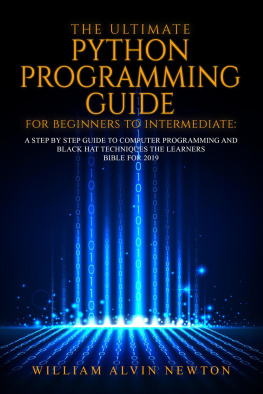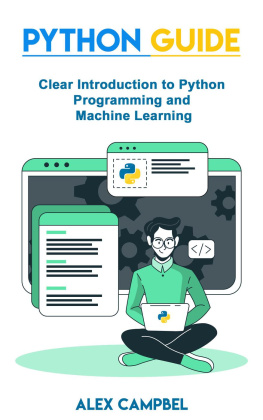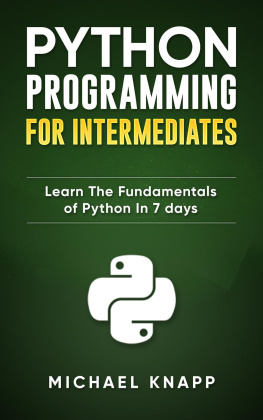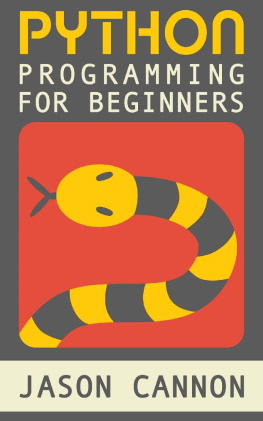
THE ULTIMATE PYTHON PROGRAMMING GUIDE FOR BEGINNERS TO INTERMEDIATE:
A STEP BY STEP GUIDE TO
C OMPUTER PROGRAMMING AND BLACK HAT TECHNIQUES THE LEARNERS
BIBLE FOR 2019
Copyright 2019 by William Alvin Newton - All rights reserved.
This eBook is provided with the sole purpose of providing relevant information on a specific topic for which every reasonable effort has been made to ensure that it is both accurate and reasonable. Nevertheless, by purchasing this eBook you consent to the fact that the author, as well as the publisher, are in no way experts on the topics contained herein, regardless of any claims as such that may be made within. As such, any suggestions or recommendations that are made within are done so purely for entertainment value. It is recommended that you always consult a professional prior to undertaking any of the advice or techniques discussed within.
This is a legally binding declaration that is considered both valid and fair by both the Committee of Publishers Association and the American Bar Association and should be considered as legally binding within the United States.
The reproduction, transmission, and duplication of any of the content found herein, including any specific or extended information will be done as an illegal act regardless of the end form the information ultimately takes. This includes copied versions of the work both physical, digital and audio unless express consent of the Publisher is provided beforehand. Any additional rights reserved.
Furthermore, the information that can be found within the pages described forthwith shall be considered both accurate and truthful when it comes to the recounting of facts. As such, any use, correct or incorrect, of the provided information will render the Publisher free of responsibility as to the actions taken outside of their direct purview. Regardless, there are zero scenarios where the original author or the Publisher can be deemed liable in any fashion for any damages or hardships that may result from any of the information discussed herein.
Additionally, the information in the following pages is intended only for informational purposes and should thus be thought of as universal. As befitting its nature, it is presented without assurance regarding its prolonged validity or interim quality. Trademarks that are mentioned are done without written consent and can in no way be considered an endorsement from the trademark holder.
Description
In The Ultimate Python Programming Guide for Beginners you will learn all the essential tools to become proficient in the python programming language. Learn how to install python in all major operating systems: Windows, Mac OS, and even Linux. You will be guided step by step from downloading the necessary files to making adjustments in the installation for your particular operating system. Learn the command line shell, and how to use it to run python in interactive and script modes.
Discover how the python interpreter functions, and learn how to use the interactive command line shell through practical examples you can try on your own. Learn datatypes and variables in depth, with example code and discussion of the generated output.
Numbers are covered in detail, including a discussion of the 4 number types in python: integer, float, complex, and boolean. Learn about Truthy and Falsy returns and how they relate to the boolean type. Practice with some of the many built-in python math functions, and discover the difference between format() and round() functions.
Strings are one of the most important variables in any programming language. Learn in-depth how to explore, search, and even manipulate strings in python. Practice with pythons built-in string methods.
Learn about pythons control structures and how to use boolean logic to achieve your software requirements.
- Deal with operators and develop an understanding of the strengths and differences of mathematical, relational and logical operators, as well as the importance of operator precedence and associativity.
- Learn about strings and the many ways to search through and manipulate them.
- Discover the power of inheritance and polymorphism.
- Learn how to open, manipulate and read, and close files on your file system.
- Learn about the philosophy and importance of code reuse, and how modules in python makes this simple.
- Examine the difference between procedural and Object Oriented programming. Which is right for you may depend on what kind of code you are writing.
- Practice control structures in python.
- Study operators and learn about operator overloading.
- An in-depth discussion of python sequences: lists, sets, tuples and dictionaries. Learn the strengths and weaknesses of each. Practice creating and manipulating python sequences.
Table of Contents
Types and Variables
Prologue:
For those listening to the audio book version it is recommended that you also purchase the paperback or kindle eBook version in order to view figures, illustrations and to see exactly how to type different codes and instructions in a precise manner. Also while narration this book I will, in order to simplify a frequently repeated fraise. I will say the computer symbols >>> ( as in less than greater than) only one time (>) unless otherwise indicated by being in the code itself. The first few chapters these (>) symbols will be repeated 3 time as they are written, to give you an idea of their place. After chapter 7 these will be repeated one as the chapters get more advanced.
C ongratulations on downloading THE ULTIMATE PYTHON PROGRAMMING GUIDE FOR BEGINNERS: A STEP BY STEP GUIDE and thank you for doing so.
You do not need to know how to code to use this book, but it does assume the reader is familiar with his or her operating system of choice, knows how to invoke a terminal or command window, and how to install and configure software. Beyond that, you should find everything you need to learn in detail how to become a python developer.
The following chapters will provide a step-by-step method to install, configure, and begin coding in the python programming language. Python is an excellent language for those new to programming, and an easy transition from other languages. It has a natural language feel and avoids many of the rigid blocking and syntax of other programming languages. Python was first developed in 1991 by Guido Van Rossum. It is called a high level language because it hides many of the details going on under the hood from the programmer. Those activities are dealt with by the python interpreter, which takes each line of text provided by the programmer and creates the machine language code required by your computer or other device to run the program.
Python is a strongly typed language, which means it does not automatically convert data types. Instead, the programmer must convert as necessary, meaning it is more difficult to make data type errors in python.
Next page












